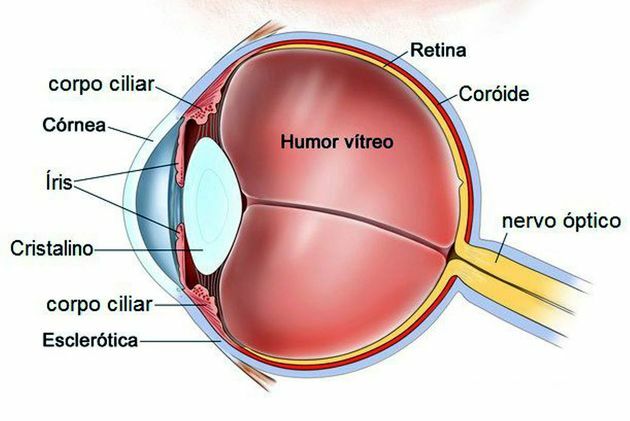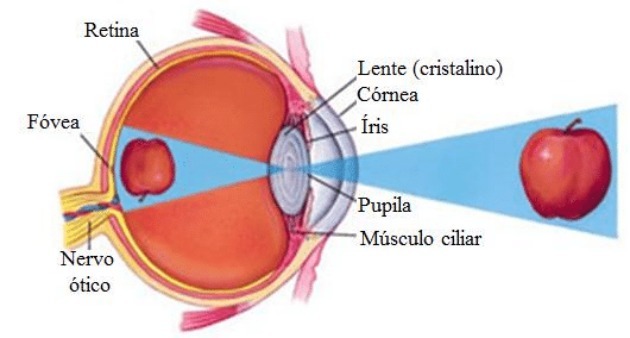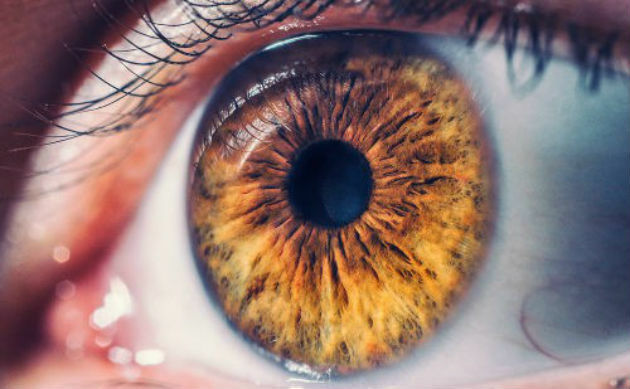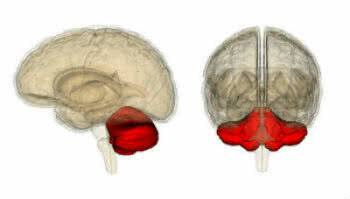The eyes are the organs responsible for seeing animals. The human eye is a complex optical system capable of distinguishing up to 10,000 colors.
The eyes have as main functions vision, nutrition and protection.
Upon receiving light, the eyes convert it into electrical impulses that are sent to the brain, where the images we see are processed.
Tears, produced by the tear glands, protect the eyes from dust and foreign bodies. The act of blinking also helps to keep the eye hydrated and clean.
Not even the most modern still cameras come close to the complexity and perfection of the eyes when capturing images.
Eye Anatomy and Histology
The eyes are sphere-shaped, 24 mm in diameter, 75 mm in circumference, 6.5 cm3 of volume and weight of 7.5 g. They are protected in bony cavities in the skull called orbits and by the eyelids.
Thus, they are protected from injury and the eyelids prevent the entry of dirt. The eyebrow also makes it difficult for sweat to pass into the eyes.
Histologically, the eyes are formed by three layers or tunics: outer, middle and inner.
Components of the Human Eye

The main components of the eye are:
- sclera: is a fibrous membrane that protects the eyeball, commonly called the “white of the eyes”. It is covered by a thin, transparent mucous membrane called the conjunctiva.
- Cornea: is the transparent part of the eye, made up of a thin, resistant membrane. Its function is to transmit light, refract and protect the optical system.
- Choroid: it is a membrane rich in blood vessels, responsible for the nutrition of the eyeball.
- ciliary body: Its function is to secrete the aqueous humor and contains the smooth muscles responsible for the accommodation of the lens.
- Iris: it is a diversely colored disc and involves the pupil, the central portion that controls the entry of light into the eye.
- Retina: the most internal and important part of the eye. The retina has millions of photoreceptors, which send signals down the optic nerve to the brain, where they are processed to create an image.
- crystalline or lens: it is a transparent disk located behind the iris with the function of performing visual accommodation, as it can change its shape to ensure image focus.
- watery mood: clear liquid located between the cornea and the lens with the function of nourishing these structures and regulating the internal pressure of the eye.
- Vitreous humor: liquid that occupies the space between the lens and the retina.
In the human eye there are two types of photoreceptors: cones and rods. Cones provide color vision, while rods are used for dark vision in black and white.
Behind the eye is the optic nerve, responsible for conducting electrical impulses to the brain for them to be interpreted.
How do eyes work?

Initially, light passes through the cornea and reaches the iris, where the pupil controls the intensity of light to be received by the eye. The wider the pupil's opening, the greater the amount of light that enters the eyes.
The image then reaches the lens, a flexible structure that accommodates and focuses the image on the retina.
In the retina there are several photoreceptor cells that, through a chemical reaction, transform light waves into electrical impulses. From there, the optic nerve takes them to the brain, where image interpretation takes place.
It is noteworthy that in the lens the image undergoes refraction, therefore, an inverted image is formed on the retina. It is in the brain that correct positioning takes place.
the color of human eyes
Eye color is determined through polygenic genetic inheritance, that is, several genes play a role in defining this characteristic.
So it is the amount and types of pigments that exist in the iris that will determine the color of a person's eyes.
In turn, the color of the iris is not uniform, it consists of two circles, the outer one, as a rule darker than the inner one, and between the two, a light, intermediate zone. It comes in four main colors: brown, green, blue and grey.
In the center of the iris is the pupil, which consists of a small circle that changes its size according to the intensity of light in the environment.

Eye Diseases
Some diseases can affect the eyes. The main ones are:
- eye allergy: it is an inflammation of the eyes caused by contact with a certain substance. The most frequent allergy is allergic conjunctivitis.
- Astigmatism: occurs when the cornea presents a change in its curvature axes, resulting in blurred vision.
- blepharitis: common and persistent inflammation of the eyelids.
- Cataract: Total or partial lens opacity producing blurred vision and faded colors.
- Conjunctivitis: inflammation of the conjunctiva.
- Strabismus: ocular deviation due to loss of normal retinal correspondence in one eye, with loss of alignment.
- hyperopia: formation of the visual image behind the retina.
- Myopia: refraction error affecting distance vision.
- rosary: it is the infection of a small gland of the eyelid, usually forms a small, palpable, painful and reddish nodule.



